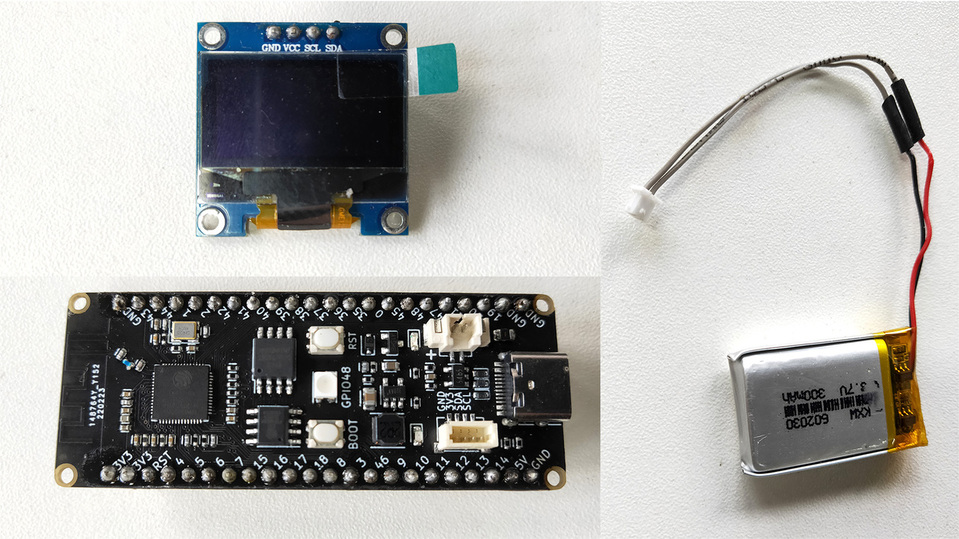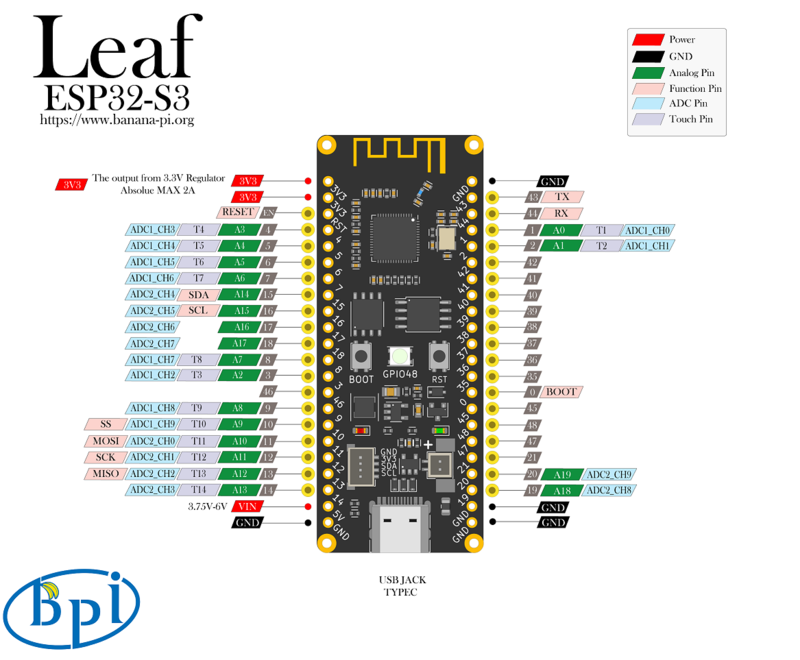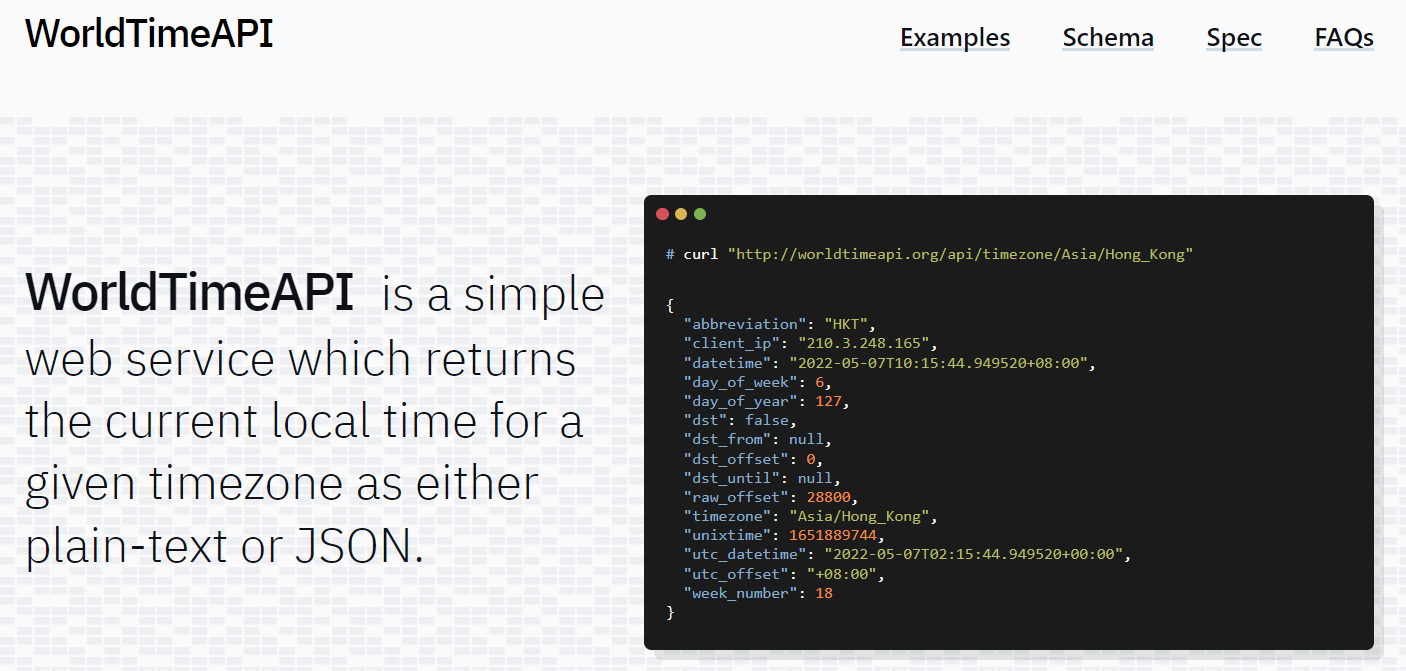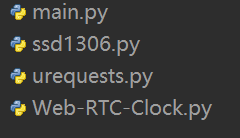Hardware preparation

- 3.7V lithium battery with ZH 1.5 2-Pin JST connector
- Any generic SSD1306 OLED display modules using I²C communication protocol
- Some wires for connection
- WiFi hotspot
BPI-Leaf-S3 :

The ESP32-S3 chip on the BPI-Leaf-S3 has two I²C bus interfaces.
There is a SH1.0 4-pin connector opposite the battery connector that can be used for I²C device connection.
SDA is connected to GPIO15, SCL is connected to GPIO16, so no matter which connection method is used, it is ok.
How to connect
| SSD1306 OLED | BPI-Leaf-S3 |
|---|---|
| GND | GND |
| VCC | 3V3 |
| SCL | 16 |
| SDA | 15 |
Get Web Clock
There are many APIs on the web that can be used to get the time , such as WorldTimeAPI .

This API is free and does not need to register an account, which is very convenient.
There are very easy to understand routines on the website, you can know how to use it in a few minutes.
To get the time in Hong Kong, for example, use this URL:
http://worldtimeapi.org/api/timezone/Asia/Hong_Kong
Libraries
In order for BPI-Leaf-S3 to get API information on the network and display it on the SSD1306 OLED, we need two libraries.
micropython-lib/urequests.py at master · micropython/micropython-lib (github.com)
micropython/ssd1306.py at master · micropython/micropython (github.com)
Download them and upload to the flash of the board.

MicroPython Code
Web-RTC-Clock.py
from machine import I2C,Pin,RTC
from ssd1306 import SSD1306_I2C
from neopixel import NeoPixel
import time,network
import urequests
SSID = "wifi-ssid"
PASSWORD = "wifi-password"
Url = "http://worldtimeapi.org/api/timezone/Asia/Hong_Kong"
week_list=["Mon.","Tue.","Wed.","Thu.","Fri.","Sat.","Sun."]
rtc = RTC()
print(rtc.datetime())
sda_pin=Pin(15,Pin.PULL_UP)
scl_pin=Pin(16,Pin.PULL_UP)
i2c = I2C(1,sda=sda_pin, scl=scl_pin, freq=800_000)
print(i2c.scan())
oled = SSD1306_I2C(128, 64, i2c, addr=0x3c)
def display():
datetime=rtc.datetime()
oled.fill(0)
oled.text("{0}/{1:0>2d}/{2:0>2d}<{3}>".format(datetime[0],datetime[1],datetime[2],week_list[datetime[3]]), 0, 0)
oled.text("{0:0>2d}:{1:0>2d}:{2:0>2d}".format(datetime[4],datetime[5],datetime[6]), 32, 8)
oled.show()
def ConnectNet():
pin_48 = Pin(48, Pin.OUT)#Use GPIO48 as the signal line of WS2812
np = NeoPixel(pin_48, 1,bpp=3, timing=1)
np[0] = (25,0,0)
np.write()
try:
wifi = network.WLAN(network.STA_IF)#Create a network interface
wifi.active(True)#activate interface
print(wifi.scan())#Output scanned SSID
if not wifi.isconnected():
wifi.connect(SSID,PASSWORD)#Connect to the specified SSID
print('start to connect wifi')
oled.text("WiFi connect", 0, 0)
oled.show()
for i in range(30):
print('try to connect wifi in {}s'.format(i))
oled.text(".", 12*8+i*4, 0)
oled.show()
time.sleep(1)
if wifi.isconnected():
oled.fill(0)
break
if wifi.isconnected():
np[0] = (0,25,0)
np.write()
print('WiFi connection OK!')
print('Network Config=',wifi.ifconfig())#Get and print the IP address, subnet mask, gateway and DNS server.
oled.text("WiFi connect!IP:", 0, 0)
oled.text("{}".format(wifi.ifconfig()[0]), 0, 8)
oled.show()
time.sleep_ms(1500)
np[0] = (0,0,0)
np.write()
else:
print('WiFi connection Error')
except Exception as e: print(e)
def net_rtc():
requests = urequests.get(Url)#Open the URL to get information through the urequests module
print(requests.text)#Output all acquired information in text form
parsed = requests.json()#Convert to json format for separating out the information
datetime_str = str(parsed["datetime"])#Extract datetime information and save to variable as string format
year = int(datetime_str[0:4])#The string is sliced and saved as an integer to the corresponding variable
month = int(datetime_str[5:7])
day = int(datetime_str[8:10])
#weekday=str(parsed["day_of_week"])
hour = int(datetime_str[11:13])
minute = int(datetime_str[14:16])
second = int(datetime_str[17:19])
subsecond = int(round(int(datetime_str[20:26]) / 10000))
rtc.datetime((year, month, day, 0, hour, minute, second, subsecond))#Update internal RTC
print(rtc.datetime())
print("RTC updated\n")
ConnectNet()
net_rtc()
while True:
display()
time.sleep_ms(100)
Modify the string type variable SSID PASSWORD to your available wifi hotspot.
main.py
with open('Web-RTC-Clock.py', encoding='utf-8') as f:
#print(u'')
exec(f.read())
Upload main.py, Web-RTC-Clock.py to the flash of the board as well.

Either battery powered or USB powered can be used.
wiki page: https://wiki.banana-pi.org/BPI-Leaf-S3